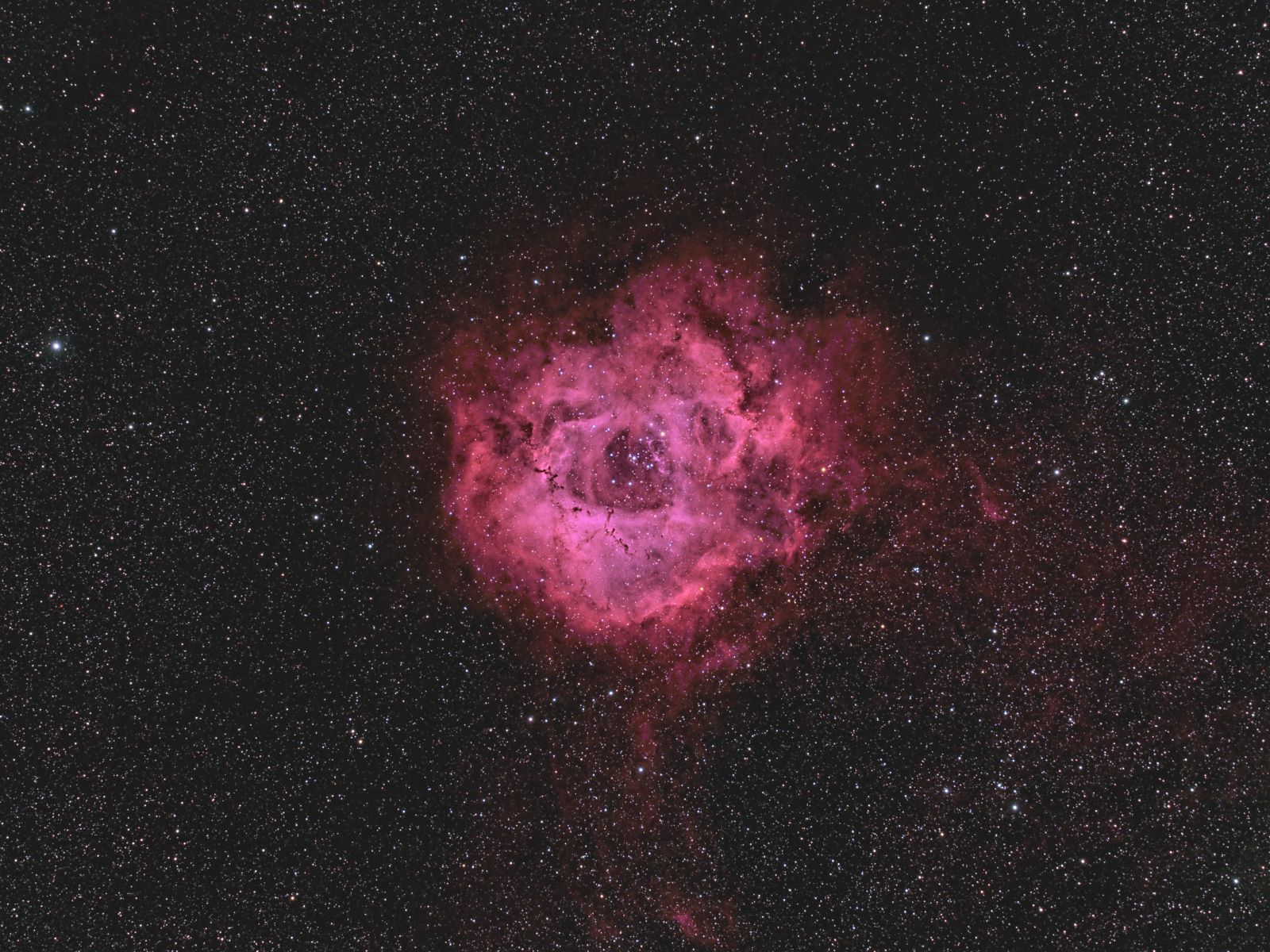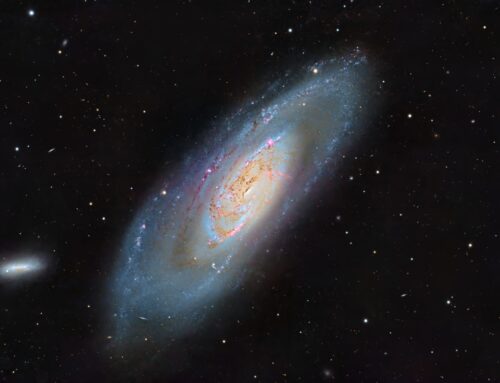The Rosette Nebula
Click image for full size version
January 12, 2020
This gorgeous donut is the Rosette Nebula. It’s very large and diffuse, and contains open cluster NGC 2244, which is in the darker centre of the nebula. The Rosette lies about 5,200 light years away in the constellation Monoceros, and is about 50 light years across. This gives it an apparent width about three times that of the full Moon. This nebula is a star nursery, with about 2,500 young stars estimated to be within it, and a total mass about 10,000 times the Sun’s. The young stars were formed from the gas and dust in the Rosette, and are now causing the gas to glow, absorbing invisible infrared star light and emitting it mostly as red and blue light that we can see.
The last time I shot this object was in December 2016. In fact, I used the colours from the stars in the 2016 image to improve the star colour in the current image.
Tekkies:
Takahashi FSQ-106 ED IV @ f/3.6, QHY367C one-shot colour camera, and Optolong L-eNhance narrowband filter, Paramount MX, unguided. Acquisition, and focusing with TheSkyX. Focus with Optec DirectSync focus motor and controller. Automation with CCDCommander. Equipment control with PrimaLuce Labs Eagle 3 Pro computer. All pre-processing and processing in PixInsight. Acquired from my SkyShed in Guelph. Variable moon, average to above average transparency and fair to average seeing. Data acquired November 23-December 24, 2019. Additional data for star colours were taken from an image acquired in 2016 as described here.
12x10m with Optolong L-eNhance filter (Total = 2hr00m)
Image scale 2.6 arcsec per pixel
Data Reduction and Cleanup
Preprocessing: The WeightedBatchPreProcessing script was used to perform calibration, debayering, and registration of all frames. LocalNormalization was used to normalize to the best frame, and ImageIntegration was used to make the master with weighting using the WBPPWGHT FITS keyword and Winsorized sigma clipping.
Gradient Removal: DBE was applied using Subtraction to remove the minimal gradient that remained after integration.
Channel Registration: To improve channel registration, the RGB colour channels were extracted and aligned with StarAlignment, using Thin Plate Splines with Distortion Correction and the green channel as the reference frame. The registered colour channels were recombined with ChannelCombination.
Lightness Extraction: RGBWorkingSpace was applied to normalize the channels, and the Lightness was extracted for separate processing as described below.
Colour
Colour Balancing: The colour image was colour balanced with ColorCalibration.
Linear Noise Reduction: MultiscaleLinearTransform was used to reduce noise in the background areas, using the process’ internal mask to protect bright structures. Layer settings for threshold and strength: Layer 1: 3.0 0.85 Layer 2: 2.5, 0.75 Layer 3: 2.0, 0.5 Layer 4: 1.0, 0.25.
Stretching: HistogramTransformation was applied to make a pleasing, bright image, with background set to an intensity of approximately 0.10.
Star Colour Replacement: My December 2016 image of the same object was aligned to the new RGB image and split into CIE L*a*b* channels using ChannelExtraction. ChannelCombination was used in CIE L*a*b* mode to replace the a* and b* channels of the new RGB image, using a star mask to limit replacement to the stars. The star mask was generated by subtracting a starless image (created with the StarNet process at default settings) from the RGB image. This mask was then converted to grey scale and stretched to make it more efficient and selective.
Lightness
Deconvolution: StarMask was applied with default settings to produce a Local Deringing Support Image. A clone of the image was stretched to use as a deconvolution mask. Deconvolution was applied (200 iterations, regularized Richardson-Lucy, external PSF made using PSFImage script with about 20 stars).
Linear Noise Reduction: MultiscaleLinearTransform was used to reduce noise in the background areas, using an internal mask to protect bright structures. Layer settings for threshold and strength: Layer 1: 3.0, 0.75 Layer 2: 3.0, 0.65 Layer 3: 1.0, 0.4 Layer 4: 0.5, 0.2.
Stretching: HistogramTransformation was applied to make a pleasing, bright image, with background set to an intensity of approximately 0.10.
Recombining Lightness and Colour Images
LRGB Combination: The lightness image was applied to the RGB image using LRGBCombination with default settings.
Additional Processing
Nonlinear Noise Reduction: TGVDenoise was used in L*a*b* mode to reduce noise with a mask used to target the background areas and protect the stars (max. 1000 iterations and convergence selected for both lightness and chrominance).
Contrast Enhancement: LocalHistogramEqualization was applied twice (scale of 50 with strength 0.63; then scale of 150 with strength 0.35) using a mask to protect stars and low-signal regions of the image. The mask was a stretched version of the Lightness image with stars removed using the StarNet process.
Final Steps: Hue was adjusted using the following expression in PixelMath without rescaling, with a star mask in place to protect the stars:
R: $T[0]
G: iif([$T[0]>0.15, 0.94*$T[1], $T[1])
B: iif([$T[0]>0.15, 1.17*$T[2], $T[2])
Background, nebula and star brightness, contrast, and colour saturation were adjusted in several iterations using CurvesTransformation with masks as required. The DarkStructureEnhance script was applied with a strength of 0.4. ICCProfileTransformation (sRGB IEC61966-2.1; Relative Colorimetric with black point compensation) was applied prior to saving as a jpg.






Beautiful wide field, very nicely done!!